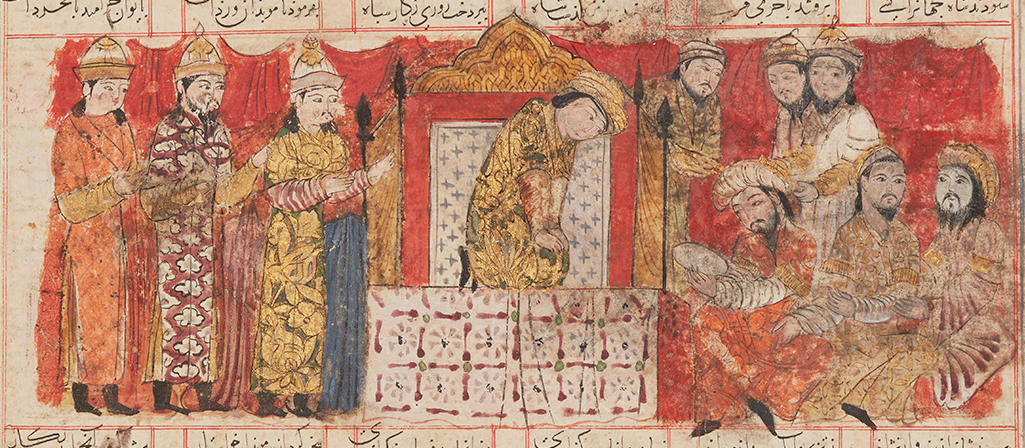
Create an Amazon Business Account
Ilkhanid Illustration
Anushirvan's fourth majlis for Buzurjmihr
from the 1341 Inju Shahnama, Shiraz



KISRA NUSHINRAVAN’S FOURTH BANQUET FOR BUZURGMIHR AND THE ARCHIMAGES
FOLIO FROM A DISPERSED COPY OF FIRDAUSI’S SHAHNAMEH (BOOK OF KINGS)
Accession Number: AKM36
Place: Iran, Shiraz
Dimensions: 35.3 x 28 cm
Date: 741 AH / 1341
Materials and Technique: Ink, coloured pigments and gold on paper
Spanning three eras and the reign of 50 monarchs, the epic poem the Shahnameh (Book of Kings), completed by Firdausi in 1010, recounts the story of Iran from its earliest beginnings to the arrival of the Muslim Arabs in the mid-7th century AD. Among the many rulers featured in the Shahnameh, Khusrau I (r. 531–579 AD) is by far the most admirable. Called “Kisra” in Firdausi’s verse, he established a just administration, regularized Iran’s tax system, and secured its borders against invasion, ensuring his country’s prosperity. Firdausi tells us that one night, Kisra had a disturbing dream in which a sharp-tusked boar sat down beside him and demanded to drink from his goblet. The next morning Kisra summoned a dream interpreter, along with his archimages (high priests), but no one could explain his nighttime reverie. He sent out emissaries all over the land to find a knowledgeable dream interpreter. Eventually a royal envoy came upon a handsome young boy named Buzurgmihr, who had astonishing powers of interpretation and prognostication. Back at Kisra’s court, Buzurgmihr amazed everyone with his knowledge, eloquence, cleverness, and ingenuity. When he grew older, Buzurgmihr gained the position of vizier or minister to the king.
Further Reading
In the verses covering both sides of this page AKM36 (folio 256 verso) from the dispersed 1341 Shahnameh, Firdausi describes the fourth of seven gatherings held by Kisra to debate the true nature of kingship and standards of kingly conduct. The horizontal illustration depicts Kisra kneeling on a high-backed throne, resting his hands on his knees. He asks his archimages to explain sovereignty, the crown, and power, and how good fortune begins and ends. When the sages’ replies do not suffice, the king turns and leans towards Buzurgmihr, seated to the right. The wise vizier, now bearded and wearing a turban, seems to be looking into a round object, possibly a cup or mirror, which is not mentioned in the Shahnameh text. He begins his discourse by praising Kisra, whose second name, Nurhinravan, means “Immortal Soul”: “Oh shah, most loving and serene of heart! Know that in all the world [there is] no king like you for justice, understanding, crown and throne.” The two archimages on the floor next to Buzurgmihr gesture towards him as they absorb his words. Other courtiers send behind on either side of the throne.
The lack of pigment in the left side of the illustration may confirm the argument that the 1341 was hastily painted. There is also evidence that black beards were painted over the men’s faces at a later time. It is likely that the overpainting occurred when the illustrated 1341 folios were removed from their “parent” manuscript and began to appear on the art market in the early 20th century.
— Marianna Shreve Simpson
Source: Aga Khan Museum
Geneva, Aga Khan Trust for Culture
Title of Work: Shahnama (1341)
Manuscript: 2005.1.28-37 (Ir.M. 6-6/I)
Accession Number: 2005.1.36 (Ir.M. 6/H)
Chapter 41 - Kisra Anushirvan (48 years)
Scene: Aushirvan's fourth majlis for Buzurjmihr
Dimensions (h x w): 96 x 240 mm
Format: Rectangular within borders
Reconstructed Folio: 256v
Hijri Date: 741 Dhu'l-Qa'da 20
Gregorian Date: 1341 May 14
School: Inju'id Shiraz
Source: Shahnama Project